Your child just started kindergarten, and you wonder what reading skills they should develop this year. You want to support their learning but feel unsure about what schools expect at this stage. Kindergarten reading standards can sound complex and overwhelming when you first hear about them.
These standards are simply a roadmap of the reading skills children typically learn by year's end. They help teachers plan lessons and give you clear ways to support learning at home. Understanding these standards means you can celebrate your child's progress and know exactly where to focus your efforts.
This guide breaks down kindergarten reading standards in simple terms. You will learn what skills matter most, how teachers use these standards, and practical ways to help at home. By the end, you will feel confident about supporting your child's reading journey.
Key Takeaways
-
Kindergarten reading standards outline clear learning goals that build the foundation for lifelong literacy.
-
These standards guide teachers in planning structured lessons and help parents understand how to support reading growth at home.
-
Reading development in kindergarten covers story understanding, factual comprehension, foundational phonics, and reading fluency.
-
Progress is measured through observation and activities rather than formal testing, with a focus on each child’s individual growth.
-
Consistent reading practice at home, paired with engaging instruction, creates confident and motivated young readers.
What Are Kindergarten Reading Standards?
Kindergarten reading standards outline the key skills and knowledge children are expected to develop by the end of their first year of school. They act as learning goals that guide teachers, parents, and caregivers in supporting early literacy growth.

In Australia, the Early Years Learning Framework (EYLF), managed by ACECQA, provides the foundation for kindergarten education. It supports balanced development across academic, social, emotional, and physical areas. As children progress, the Australian Curriculum, Assessment and Reporting Authority (ACARA) expands these standards into specific learning areas for primary school.
Kindergarten reading standards serve three primary purposes:
-
Ensure consistent, high-quality literacy instruction across schools.
-
Help teachers plan lessons that build reading skills step by step.
-
Give parents clear ways to track and support reading progress at home.
Most frameworks group reading standards into categories such as:
-
Literary texts – understanding stories and characters.
-
Informative texts – recognizing facts and main ideas.
-
Foundational skills – letter recognition, phonics, and vocabulary.
These standards describe what children should know by the end of kindergarten, not what they must know when they begin. Every child develops at a different pace, and teachers use these standards to support each learner’s growth.
Regular reading at home plays an important role in meeting these goals. Sharing books builds vocabulary, comprehension, and a lifelong love of reading, key outcomes kindergarten reading standards aim to nurture.
Overview of the Kindergarten Reading Standards Framework
Understanding the reading standards framework helps you see the complete picture of kindergarten literacy development. Each category builds specific skills that work together to create confident, capable readers.
The framework covers four main areas that support different aspects of reading development. Your child will work on understanding stories, learning from factual texts, mastering basic reading mechanics, and building smooth reading skills. Each area plays a vital role in creating strong literacy foundations.
Let’s have a look at them in detail.
1. Reading Literature Standards
Reading literature standards focus on how children understand and think about stories. Your child learns to go beyond just hearing words to actually making sense of narratives. These skills help them connect with characters, follow plotlines, and develop a love of stories.
Here are the key skills your child develops in this area:
-
Ask and answer questions about story details – Your child learns to think critically about what happens in stories and why events occur.
-
Retell familiar stories in order of events – This skill shows they understand story structure and can remember key moments from beginning to end.
-
Identify characters, settings, and main events – Children learn to recognize who stories are about, where they take place, and what important things happen.
-
Recognize the roles of authors and illustrators – Your child understands that different people create the words and pictures in books.
-
Compare and contrast similar stories – This advanced skill helps children see connections between different tales, like noticing patterns in fairy tales.
To strengthen this, teachers often read stories aloud daily and lead discussions about characters and events. You can support this learning at home by asking simple questions after reading together. Try asking your child who their favorite character was or what happened first in the story.
2. Reading Informational Text Standards
Informational text standards teach your child to learn from factual books and real-world content. These texts differ from storybooks because they share true information rather than made-up tales. Building skills in this area helps children learn from textbooks, instructions, and reference materials throughout their education.
Here are the skills children develop with factual texts:
-
Ask and answer questions about key details – Your child learns to identify and remember important facts from what they read.
-
Identify the main topic or idea – This skill helps them understand what a text is primarily about.
-
Describe how pictures support understanding – Children learn that photos, diagrams, and illustrations teach information just like words do.
-
Recognize basic text features – Your child begins noticing titles, headings, and other organizational elements that help readers navigate texts.
Teachers often use nonfiction books about animals, weather, community helpers, and other topics that interest young children. At home, you can read picture books with real information or point out text features in magazines and signs. Show your child how the table of contents helps them find specific details, and how bold words highlight important terms.
Also Read: Reading Comprehension Games and Activities for Students
3. Foundational Reading Skills Standards
Foundational skills form the mechanical basis of reading. These are the nuts and bolts that allow your child to actually decode words on a page. Without these skills, children cannot access the meaning of written text.
Here are the essential foundational skills kindergartners develop:
-
Understand print concepts – Your child learns that English text flows from left to right and top to bottom, and they recognize spaces between words.
-
Recognize and name all letters – Children master both uppercase and lowercase letters in the alphabet.
-
Demonstrate letter-sound relationships – This crucial phonics skill is developed by connecting each letter to its corresponding sound.
-
Blend and segment sounds – Your child learns to push sounds together to read words and pull words apart into individual sounds.
-
Read common sight words – These high-frequency words like "the," "and," and "said" appear so often that children learn to recognize them instantly.
-
Read simple texts with understanding – Your child applies all these skills to read beginner books that match their current level.
Phonics lessons, word games, and guided reading sessions build these skills in the classroom. At home, you can practice letter sounds during everyday activities like grocery shopping or car rides. Sound out simple words together, practice sight word flashcards, and always celebrate progress, no matter how small.
Research indicates that with quality teaching focused on these foundational skills, over 90% of students can learn to read successfully. This highlights the importance of systematic phonics instruction and practice during kindergarten.
Also Read: 35+ Read Aloud Books for Kindergarteners
4. Fluency and Comprehension Standards
Fluency means reading smoothly and accurately, rather than stopping and starting with each word. Comprehension means understanding what those words mean. These two skills work together to create readers who can both decode text and grasp its meaning.
Here are the fluency and comprehension goals for kindergarten:
-
Read short sentences or simple books accurately and smoothly – Your child develops the ability to read connected text rather than isolated words.
-
Use pictures and context to confirm understanding – Children learn to check whether their reading makes sense by looking at illustrations and thinking about the story.
-
Retell stories or facts in their own words – This skill demonstrates true comprehension because your child must process information and express it differently.
Teachers use repeated reading of short books and daily read-alouds to build these skills. When the same book is read multiple times, children gain confidence and fluency. At home, encourage your child to read favorite books over and over. Ask them to tell you about what they read in their own words rather than reciting memorized text.
The journey from early letter recognition to fluent reading happens gradually throughout kindergarten and beyond. Each small step forward builds toward independent reading skills that will serve your child throughout their education.
How Reading Standards Are Assessed?
Teachers use various methods throughout the year to understand how your child is progressing toward the reading standards. These assessments look different from traditional tests because kindergartners learn best through active participation rather than sitting for exams. Assessment happens naturally during regular classroom activities.

Assessment in kindergarten focuses on growth rather than comparing children to each other. Your child's progress is measured against the standards and their own starting point. This approach recognizes that all children develop at their own pace while still moving toward common literacy goals.
Here are the main ways teachers assess reading standards:
-
Classroom observation – Teachers watch your child during reading activities, small group work, and independent practice to notice which letters they recognize and how they approach unfamiliar words.
-
Running records – Your child reads aloud while the teacher notes exactly what happens, recording correct words, struggles, and strategies used to show reading accuracy and fluency patterns.
-
Short reading tasks – Teachers ask your child to point to letters, sound out simple words, or answer questions about stories to check specific skills.
-
Letter and sound identification checks – Your child demonstrates knowledge of uppercase and lowercase letters and their corresponding sounds through quick individual assessments.
-
Sight word assessments – Teachers track which high-frequency words your child can recognize instantly without sounding them out.
-
Comprehension checks – Your child retells stories or answers questions to show they understand what they read or heard.
You typically receive progress reports through regular parent-teacher conferences and written reports. Teachers share specific information about your child's reading development in each standards area. They explain what your child does well and where they are working to improve. This communication helps you understand exactly how to support learning at home.
Also Read: 25+ Guided Reading Games for Kids with Practical Tips for Success
How do Teachers Use the Reading Standards?
Reading standards serve as the foundation for everything teachers plan and do in literacy instruction. These standards guide daily decisions about which skills to teach, how to group students, and when to provide extra support. Understanding how teachers use standards helps you see the planning behind classroom activities.

Teachers plan lessons that systematically address each strand throughout the year. They design activities that build skills progressively from simple to complex. Early in the year, lessons might focus heavily on letter recognition and basic phonics. As the year progresses, activities incorporate more complex skills, such as blending sounds and reading simple sentences.
Here are the main ways teachers apply reading standards in the classroom:
-
Curriculum planning – Teachers map out which standards to address each week and month, ensuring all areas receive appropriate attention throughout the year.
-
Assessment design – Standards guide what teachers assess and how they measure progress, helping them understand exactly which skills each child has developed.
-
Small-group instruction – Teachers form flexible groups based on which standards students need to work on, providing targeted teaching that matches each child's current level.
-
Intervention decisions – When children struggle with specific standards, teachers provide additional support through focused intervention activities.
-
Progress monitoring – Standards give teachers clear benchmarks to track whether students are on pace to meet year-end goals.
Standards connect directly to phonics programs, sight word lists, and comprehension activities your child experiences. When teachers introduce a new phonics pattern, they are addressing foundational skills standards. When they discuss a story after reading aloud, they are working on literature standards. Every literacy activity in kindergarten is purposefully designed to align with the reading standards for kindergarteners.
Practical Tips to Support Kindergarten Reading at Home
The reading standards describe where your child should be by year's end, not where they need to be right now. This distinction matters because it helps you avoid feeling anxious when your child is still developing certain skills. Every kindergartner moves at their own pace while working toward those same end goals.

Home activities that support reading do not require special materials or teacher training. The most powerful support you can provide is reading aloud regularly, talking about stories and information, and playing with letters and sounds. These simple activities reinforce everything your child learns in the classroom.
Here are targeted ways to support each standard area at home:
For Reading Literature
Ask your child to tell you who was in the story after you finish reading. This simple question builds comprehension and retelling skills. Encourage them to describe what happened first, next, and last to practice sequencing events.
For Reading Informational Text
Choose nonfiction picture books about topics your child finds interesting. After reading about animals, space, or vehicles, ask what they learned. Point out how the pictures help explain information.
For Foundational Skills
Play sound games during everyday activities. Ask what sound your child hears at the beginning of words like "mom" or "dad." Practice finding letters on signs during grocery trips or walks around the neighborhood.
For Fluency and Comprehension
Let your child read the same favorite books repeatedly. Repetition builds fluency and confidence. Even if they have memorized the text, they are practicing reading behaviors and developing a sense of achievement.
General Support Strategies
-
Create a cozy reading space at home where your child can look at books independently.
-
Visit the library regularly to access free books and reading programs.
-
Show enthusiasm about reading by sharing what you read and why you enjoy it.
-
Keep reading time positive and pressure-free if your child resists reading.
-
Make it fun through silly voices, acting out stories, or letting them choose what you read together. The goal is to build a love of reading alongside developing skills.
Remember that talking about stories matters just as much as reading words on a page. When you ask questions, make predictions, and discuss characters, you teach critical thinking skills that support reading comprehension. These conversations show your child that reading is about understanding and enjoying content, not just saying words correctly.
Conclusion
Helping your child learn to read doesn’t have to feel complicated or stressful. Once you understand what schools aim for through kindergarten reading standards, it becomes much easier to see how everyday moments can support that growth. Whether it’s chatting about a bedtime story, pointing out letters on street signs, or celebrating a new sight word, every small step adds up.
The real goal isn’t just meeting benchmarks, it’s nurturing confidence, curiosity, and joy in reading. When your child feels proud of what they can do, they’re more likely to keep exploring books long after kindergarten ends.
If you want additional support for your child's reading development, consider the FunFox Readers Club. This program explicitly addresses the reading standards kindergartners work toward. Here's how FunFox supports young readers:
-
Small group classes with only 3-6 students – Your child receives personalized attention that addresses their specific needs and current skill level.
-
Weekly one-hour live Zoom lessons – Convenient online format fits into your family schedule without travel time or location barriers.
-
Teachers trained in the FunFox Way – Dedicated educators use evidence-based methods to build foundational reading skills, such as fluency and comprehension.
-
Interactive activities and educational games – Engaging lessons keep kindergartners motivated and make reading practice enjoyable rather than tedious.
-
All sessions recorded for review – Your child can revisit concepts they found challenging or catch up on any missed classes.
-
Digital portal with worksheets and reading materials – Access supplementary resources that reinforce skills learned during live lessons.
-
Focus on confidence building – The program addresses reading anxiety and helps reluctant readers develop positive attitudes toward books.
The Readers Club aligns with curriculum standards while making reading development engaging and supportive. Your child will benefit from expert instruction, peer interaction, and resources tailored to their age and skill level.
Ready to give your child the reading support they deserve? Book a trial class with FunFox Readers Club today and watch your kindergartner develop the literacy skills that will serve them throughout their education.
FAQ’s
1. What level should a 5-year-old be reading at?
Most five-year-olds recognize letters, know basic sounds, and read simple words or short sentences. Reading levels vary widely, so consistent exposure and support matter more than specific benchmarks.
2. What should a kindergarten student be able to read?
Kindergartners typically read simple, predictable texts with familiar words, identify sight words, and use pictures or context clues to understand meaning as they develop early comprehension skills.
3. What are the five basic reading skills?
The five essential reading skills are phonemic awareness, phonics, fluency, vocabulary, and comprehension. Together, these build the foundation for successful, independent reading development.
4. Can a kindergartener read fluently?
Most kindergartners are still developing fluency. They read slowly, sound out words, and rely on pictures. With regular practice, accuracy and smoothness gradually improve over time.
5. How do schools assess reading levels?
Schools use observations, guided reading sessions, and short assessments, such as letter recognition checks, running records, and comprehension questions, to track each child’s reading progress throughout the year.















